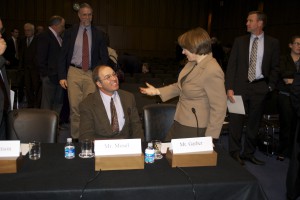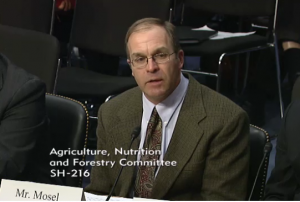In its “Path to the 2012 Farm Bill” series, NSAC gets into the details of the 2012 Farm Bill debate.
On Tuesday, February 28, the Senate Agriculture Committee held its second Farm Bill hearing of the year. The hearing, entitled “Strengthening Conservation through the 2012 Farm Bill,” brought together three farmers, representatives from three national non-profit organizations, and the heads of USDA’s Natural Resources Conservation Service (NRCS) and Farm Service Agency (FSA) to testify to the value of the Farm Bill conservation programs.
Senator Debbie Stabenow (D-MI), Chairwoman of the Committee, began the hearing by stating that the conservation programs are now more essential than ever to creating jobs and protecting vital natural resources across the country. Chairwoman Stabenow pointed to the importance of ensuring that the country’s 1.3 billion acres of agriculture produce healthy soil, water, and wildlife habitat.
In her opening remarks, Stabenow commented on a number of letters that she had received in support of the farm bill conservation programs, including one signed by NSAC and more than 640 other organizations. She also received a letter from the major commodity groups stating, “The conservation efforts in the Farm Bill are critical to a strong economy, healthy and productive rural lands and vibrant communities.”
In addition to Chairwoman Stabenow and Ranking Member Pat Roberts (R-KS), Senators Tom Harkin (D-IA), Amy Klobuchar (D-MN), Michael Bennet (D-CO), John Boozman (R-AR), Chuck Grassley (R-IA), John Thune (R-SD), Saxby Chambliss (R-GA), and Max Baucus (D-MT) attended the hearing.

Farmer Darrel Mosel chats with MN Senator Amy Klobuchar
All of the witnesses spoke favorably about the conservation programs, with particularly strong praise being given to the Conservation Stewardship Program (CSP), Wetlands Reserve Program (WRP), Conservation Reserve Program (CRP), and the conservation partnership programs.
On the first panel, NRCS Chief Dave White, stated his support for the Conservation Title that was included in the bill that Senators Stabenow and Roberts prepared last year with the leaders of the House Agriculture Committee.
That bill, which Committee leadership had hoped to pass as part of the now-defunct Supercommittee process, would retain the purpose and functionality of each conservation program while making innovative and substantial changes to the Title. It would also, however, cut roughly $6.3 billion from the Title over 10 years, on top of the over $4 billion Congress has sliced from the farm bill conservation title in annual USDA funding bills.
Much of the proposed Supercommittee cut (roughly 60 percent) would come from the CRP. To a significant degree, this reduction would track changes in CRP enrollment expected as a result of market forces; more than 6 million acres will expire at the end of this fiscal year alone, though a portion of that total may be re-enrolled.
Senator Pat Roberts, Ranking Member of the Committee, asked FSA Administrator Bruce Nelson and NRCS Chief Dave White how best to conserve environmentally sensitive land that is coming out of CRP. Nelson highlighted the CRP Transition Incentives Program (CRP-TIP) and noted that the program has been extremely popular over the last several years. In fact, FSA announced this week that it has allocated all the funding provided for CRP-TIP in the 2008 Farm Bill.
CRP-TIP offers a special incentive of two years of extra CRP rental payments to owners of land that is currently in the CRP but returning to production, who rent or sell to beginning or socially disadvantaged farmers and ranchers who will use sustainable grazing practices, resource-conserving cropping systems, or transition to organic production. You can read more about the program’s success in our press release from earlier today. Last year’s Farm Bill draft included $25 million in renewed funding for CRP-TIP.
In addition to CRP-TIP, NRCS Chief Dave White and Senator Roberts conversed about the importance of keeping expiring CRP acres in grass and about allowing farmers to enroll in working lands conservation programs in the last year of their CRP contract. Producers are currently not allowed to enroll in the working lands programs while enrolled in CRP. In the case of the Conservation Stewardship Program, NRCS has interpreted this prohibition to mean that producers cannot even apply for CSP while their CRP contracts are active, meaning that producers have to wait a full year after their CRP contract expires to apply to the CSP. Ranking Member Roberts was receptive to a request by Chief White for greater flexibility and the statutory authority to help keep expiring CRP acres in grass.
Between questions from Senators and testimony from the farmer panelists, much of the hearing focused on the Conservation Stewardship Program. Senator Harkin asked NRCS Chief Dave White to comment on the first several CSP sign ups and demand for the program. Chief White stated, “I have been stunned by the demand for this program. We have to turn millions of acres away this year. CSP is where the cutting edge in conservation will become the mainstream. It is the only way we will be able to sustain the land in order to feed 9 billion people.”
Following the agency panel, three farmers and three non-profit organization representatives shared their experiences with the farm bill conservation programs. Darrel Mosel, who operates a 600 acre diversified crop and dairy operation in Sibley County, Minnesota, spoke to the importance and effectiveness of the CSP. According to Mosel:
[The CSP] is a program that allows farmers to farm and at the same time enhance the conservation performance and environmental outcomes of their operation. I believe that CSP is a shining example of what’s right in farm policy.
The CSP is a whole farm and comprehensive working lands conservation program administered by USDA’s Natural Resource Conservation Service (NRCS). Unlike EQIP, its primary focus is management and vegetative practices. CSP targets priority resource issues in specific states and watersheds, paying farmers for the adoption of new conservation enhancements and the active management of ongoing conservation activities to help solve priority resource concerns. CSP payments are directly calibrated to environmental benefits derived from particular practices and conservation systems.
I received support for actively managing and maintaining conservation practices such as no-till, waterways, and grass buffers, and was also enabled to add a series of new conservation activities on the farm to help be an even bigger part of the solution to the major resource concerns in our watershed.
One of conservation enhancements that I elected to use that really fit my farm was the resource-conserving crop rotation. A few years back, because of some erosion issues, I worked with NRCS to use the Environmental Quality Incentives Program to lay contour strips on a portion of the farm. That EQIP support was important to get the practice in place. Now with CSP and its resource-conserving crop rotation enhancement, I can actively manage those strips with a good crop rotation combined with a limited tillage approach. We now have an excellent long rotational system that also incorporates those additional conservation measures. In my experience the two programs, EQIP and CSP, complement each other while being distinctly different in what they offer.
As deliberations continue on the next farm bill, I urge members of this committee to maintain a strong funding base for the Conservation Stewardship Program. That is my main recommendation. I wish more of the farm bill were like CSP.

Farmer Darrel Mosel testifies at the Senate Conservation hearing
Like Mr. Mosel, Carl Mattson, who is a farmer from Chester, Montana, spoke to the benefits of both CSP and EQIP. According to Mr. Mattson, simply maintaining the level of conservation that we see across the landscape now will not be enough. CSP and EQIP provide the necessary suite of conservation tools to sustain our natural resources into the future. In response to a question from Senator Baucus about CSP, Mr. Mattson stated, “I used CSP for just about every conservation need I had. The program rewarded me for what I was doing right and it motivated my neighbors to sign up and become better stewards of the land.”
Finally, in addition to the working lands and easement programs, Senator John Thune of South Dakota raised the extremely important issue of highly erodible land conversion in the Great Plains. Basic conservation requirements to protect against soil erosion and wetland drainage have been a condition of receiving farm subsidies since 1985. This conservation “compliance” has dramatically reduced soil erosion on farmland and protected wetlands, keeping land productive and important natural resources intact. Since 1996, however, subsidized crop insurance, which is now the biggest farm subsidy paid by U.S. taxpayers, has not been subject to highly erodible land and wetlands compliance. Senator Thune specifically mentioned the perverse incentive that subsidized crop insurance provides farmers by making farming on highly erodible lands a less risky and more profitable endeavor. We hope to see this problem corrected in the upcoming Farm Bill.

